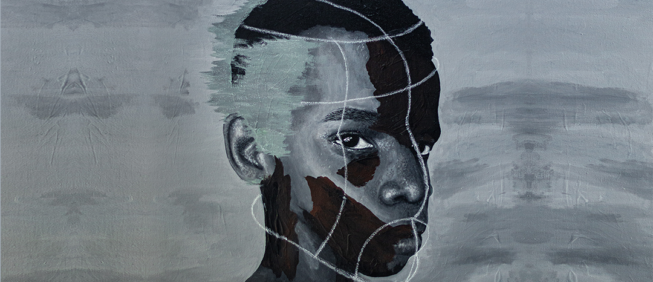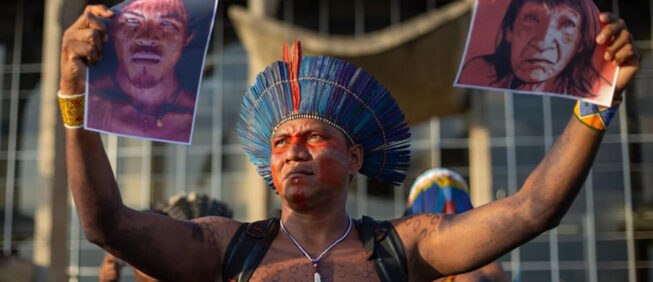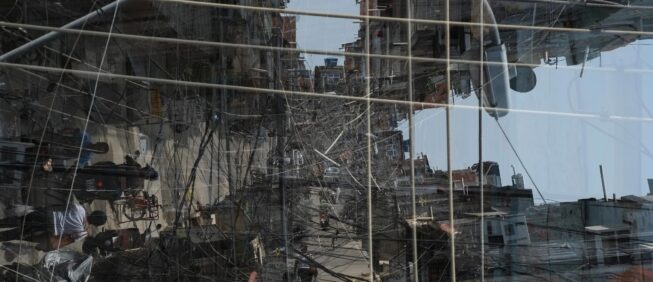Prison reforms & democracy
Raja Bagga
Madhurima Dhanuka
| India |
5 de December de 2018
Democracy presupposes equality of individuals. Every individual has their say in how they are governed. They can exercise their freedom in their everyday lives, in where they live, who they want to live with, what they eat, who they desire and the list goes on. And yet, freedom of expression is not absolute. There are always ‘reasonable restrictions.' The presence of these legal restrictions are to ensure that the actions of one does not interfere with that of another. And there are other restrictions or constraints - financial, cultural, political and social - which determine choices and actions.
These restrictions, in reality, are never reasonable, but just measures to wield power and ensure centralized control. Whose freedom is to be valued and whose is to be sacrificed is based on the class, caste, gender, ability and religion of the person. Given this context, democracy in many ways is not benign. The entire mechanism of who frames the rules, who is included and excluded, whose interests are prioritized, whose concerns are considered genuine and legitimate, who are allowed to question and who can be conveniently ignored - all these determine, or rather, are a function of power dynamics within a democracy.
It is no surprise that those behind bars are at the bottom of this pyramid. They neither have any say in how they should be governed, nor do they have effective channels to voice grievances with the policies and practices that impact their everyday life. With the absence of voting rights, they are even excluded from the election process.
It is with this context that this paper looks at relationships between prison reforms and democracy. With India as the milieu, democratic interlinkages with prison reforms, alongside crime prevention policy considerations will be discussed. The paper will highlight how public opinion and media reports have had a larger influence on policy decisions than academic research or legislative deliberations. These decisions impact reforms, but also leave the larger questions related to crime prevention and sentencing policies unanswered.

Indian Prisons: the Basics
Incarceration rates have been on the rise in most parts of the world1Global Prison Trends 2017 published by Penal Reform International. Available at https://www.penalreform.org/resource/global-prison-trends-2017/. . The need for prison reforms is widely acknowledged. High overcrowding rates, inadequate medical and mental healthcare facilities, increasing number of pre-trial detainees etc have only led to the further deterioration of prison conditions and a rise in human rights violations.
With an occupancy rate of 114.12% for its 1401 prisons and an extremely high pre-trial detainee population rate of 67.2%, the condition of Indian Prisons is as worrisome. India ranks 5th in the world in prison populations, with 419,623 imprisoned. These prisons continue to be governed by the archaic Indian Prisons Act of 1894 and state prison manuals. Prison, as a subject of legislation, is placed under the ‘State List’ of the 1950 Indian Constitution, meaning that states have the onus of framing the rules that govern prisons. As a result, prisons in different states vary in their organization, management, rules and models. This has also meant that reforms in the prison system are at different stages in different states. While some states have taken the lead others have made little or no efforts in this direction.
It is no coincidence that the overwhelming majority of prisoners in India come from economically weak and disadvantaged sections of society and have limited knowledge of their legal rights. Also, the quality of state funded ‘free’ legal aid lawyers is quite problematic. To add to that, the busiest high courts in the country spend less than four minutes per hearing. Consequently, a substantive number of those awaiting trial do not get bail. It comes as no surprise then that two-thirds of the prison population in India are undertrials.2Awaiting trial in prison Globally, only 13 countries3Entry 4, List II of Article 7, Indian Constitution (1950). States hold sole power in legislating state prison affairs. fare worse on undertrial to convict ratios.
With such high pretrial detention rates, the criminal justice system effectively curtails the liberty of people for indefinite time periods even though their guilt has not been established. And it is no surprise that two-thirds of this prison population are Scheduled Castes, Scheduled Tribes, and Other Backward Classes, the dispensable section of whom can be used as scapegoats for the ‘security’ of the rest of the population. This high proportion of undertrial population also mean that prisons usually end up being overcrowded. More than 100 jails in India have overcrowding rates of more than 100%. To add insult to injury, these overcrowded prisons are under the control of ill-trained and understaffed prison departments. The toxic combination often means more violence behind bars.
Given these daunting obstacles, reforming prisons seems like a distant dream. The primary challenge with prison reform is the gap between the policy and the legislation on one hand, and the legislation and practice on the other. Legislative changes take years, if not decades. There are changes which relate to controversial issues or require huge financial outlay and therefore require detailed deliberations and time. However, unfortunately, amendments which aim to guarantee even the most basic fair trial rights move at a snail’s pace. This is thanks to the majoritarian apathy which is very much a characteristic of democracy. Another challenge with the policy framework in the criminal justice space is the disjointed process in which each institution functions. Disregarding the interdependency of the institutions, amendments to the functioning of the prisons, police, courts and prosecution take place without evaluating the impact of one on another. The United Nations Office on Drugs and Crime (UNODC) in its guidance note, Prison Reform and Alternatives to Imprisonment, suggests that ‘effective prison reform is dependent on the improvement and rationalisation of criminal justice policies, including crime prevention and sentencing policies, and on the care and treatment made available to vulnerable groups in the community.’4State of Indian Judiciary. Available at: http://dakshindia.org/state-of-the-indianjudiciary/11_chapter_01.html#_idTextAnchor009

Prison Reforms vis-à-vis Democracy
‘Practices of punishment and confinement exist in complex relationships to and with democracy. In denying liberty, prisons exist in antithesis to the freedom which undergirds democracy and democratic citizenship. At the same time, prisons lie at the core of criminal policy considerations in society. This, when further extrapolated, infers that prison reforms and democracy, when juxtaposed will and should have considerable impact on each other. This argument finds support in the growing recognition of the fact that “reform of the prison system should therefore always take into account the needs relating to the reform of the criminal justice system as a whole and employ an integrated, multi-disciplinary strategy to achieve sustainable impact.”5 World Prison Brief; available at http://www.prisonstudies.org/highest-to-lowest/pre-trial-detainees?field_region_taxonomy_tid=All
But how are these needs accounted for while framing policy? If prisoners’ voices are often unheard or considered irrelevant, then is it public opinion that plays an integral role in framing of criminal justice policies? Or should there be reliance upon background research, consultations and audit of earlier policy decisions which should guide law makers in framing policies? There seems to be no one answer to these questions.
“The exact relationship between policy formation and public opinion remains a matter for speculation as to whether public opinion informs policy or policy informs opinion.”6Editor's Note: Scheduled Castes, Scheduled Tribes e Other Backward Classes are socio-religious minorities, given collective terms by the Indian Government. Such terms are used to classify castes in positions of educational and economic inequality. In a democracy, the elected government is responsible for representing the sentiments of the public while framing policy decisions, yet public opinion in itself can be ill informed or ill-founded or based in bias. At the same time, it is emphasized that ‘to prevent the public from losing faith in the system it is necessary that there is at least some congruence between public opinion and criminal justice arrangements and procedures.’7https://www.unodc.org/unodc/en/justice-and-prison-reform/prison-reform-and-alternatives-to-imprisonment.html While the faith of the public in the system is important, it cannot be attained at the cost of the liberty of others.
All this must be considered bearing in mind that legislative changes can have long-term irreversible implications and therefore the process requires time, effort and due diligence and must ensure adequate representation and deliberation. As such, the process should involve identifying the cause of action the amended legislation seeks to address, evaluating the immediacy and impact of the change being suggested; conducting extensive research; undertaking adequate consultations, especially with the relevant stakeholders; evaluating financial and other implications of the suggested change, among other things.
Having identified the landscape, this article now looks at recent decisions and developments in criminal justice and prison reforms in India to understand what have been the primary considerations that have effectuated any steps to reform systems.
a) Government Initiatives:
The Ministry of Home Affairs as well as the Ministry of Law & Justice in India have, in the last few years, taken up a slew of initiatives that address some of the key issues affecting Indian Prisons.
These initiatives include the highly ambitious National Mission for Delivery of Justice and Legal Reforms,8Fran Buntman, Prison and Democracy: Lessons Learned and Not Learned, from 1989 to 2009, International Journal of Politics, Culture, and Society, (Sep. 2009), pp 402. increased investment in information and communications technology to bring together all concerned agencies under the ‘Interoperable Criminal Justice System’ and make court process ‘paperless’; issued advisories and guidelines on a number of issues concerning prisons such as overcrowding, implementation of statutory bail provisions, constitution of periodic review committees to review cases of prisoners etc.
Additionally, there has been an increased emphasis on research through its research wing, the Bureau of Police Research and Development (BPRD), as well as on the quality of training being imparted to prison officers as well as other stakeholders. As part of these initiatives, efforts are ongoing to revise the century old colonial Prison Act, whereas the Model Prison Manual has already been prepared and circulated in 2016. These have been developed after extensive consultations with prison departments and civil society. This was followed by developing comprehensive modules for prison officers and wardens.
The government has also tried to put in effect the recommendations of reports tabled by Parliamentary Committees that have been constituted to look into various aspects of criminal justice policy. For instance, the Standing Committee on Empowerment of Women prepared an extensive report9https://www.unodc.org/unodc/en/justice-and-prison-reform/prison-reform-and-alternatives-to-imprisonment.html. on ‘Women in Detention and Access to Justice’ which reflects upon the conditions of women prisoners in India and made detailed recommendations.
b) Decisions as an outcome of public opinion:
While the broader policy frameworks mentioned above were developed through extensive research and deliberation, many legislative changes have unfortunately been a consequence of individual incidents, alignment with public perceptions and vote-bank politics.
There were 48, 31, 515 (4,831,515) crime incidents reported in India in 2016. These range from murder, rape, theft, kidnapping, and cyber-crime among others. While most of these cases simply became a part of the statistics, some of them have lasting impacts on the policy and law.
The 2012 Nirbhaya case10Jane Louise Wood, Why public opinion of the criminal justice system is important. Available at https://www.researchgate.net/publication/285267322_Why_public_opinion_of_the_criminal_justice_system_is_important. is the perfect example of this phenomenon. This gruesome rape sparked outrage from all sections of the society across the country. There were protests, candle light marches and discussions in parliament, in newsrooms and households. The outrage led the government to form a committee to review the criminal procedure code, and the committee had extensive consultations and feedback from various civil society groups. The committee submitted its report within 30 days of its constitution, paving the way for an amendment in the code. However, while the recommendations of the committee were taken on board by the government, the focus was not on better policing or improving evidence-gathering procedures, but to appear “tough on crime.” Therefore, while the committee suggested that enacting the death penalty for rape would be a regressive step, the criminal amendment included death penalty in rape cases. Further, the treatment of juveniles as adults in cases of heinous crimes was also included in the criminal code, another aspect the committee had recommended against. This was despite the fact that in the last couple of decades, the jurisprudence around the need to strengthen juvenile justice and challenges with the use of death penalty had been developing.
Flowing from the Nirbhaya case, another instance which had serious repercussions on Indian prisons was a film documentary where one of Nirbhaya’s rape accused11 Morgan, R (2002) `Privileging public attitudes to sentencing?’ in J.V.Roberts and M.Hough, Changing Attitudes to Punishment: Public opinion, crime and justice (Willan Publishing), pp. 215-228. was interviewed. The outrage over the documentary was widespread and made headlines. The knee jerk reaction of the government was to issue a regressive advisory12 http://pib.nic.in/newsite/PrintRelease.aspx?relid=133443. prohibiting visits by researchers, organizations, students, media to prisons. The advisory undid the openness in the institution achieved through years of jurisprudential pronouncements and civil society advocacy and made the functioning of the institution even more opaque.
Another interesting case which promises to have a far reaching impact on the condition of Indian prisons is the attempts to extradite Vijay Mallya, a businessman and former politician. The extradition process has been thwarted by the reports about deplorable conditions of Indian prisons. The relentless media campaign on this case, pressure from the opposition and the international gaze seems to have given the government the necessary impetus to bring about the recent reforms on prisons. The next section further elaborates the role of the media in effecting change.
c) Reactions to media reports, articles etc:
Prisons are a closed institution and people in general have limited information about life on the inside. For the majority, the understanding of crime, punishment and prison comes through media. Media plays an important role in the shaping of public opinion and thus policies. People often consider those behind bars as ‘others’ or ‘outlaws’ and have little faith in rehabilitation of inmates. The reportage around crime and prison re-affirms this perception. Scandals or favors wherein people in power have escaped the wrath of the law makes headlines, while incidents regarding violence or injustices with prisoners usually go unnoticed. This fuels a perception that prisoners live a luxurious life after committing heinous crimes. For cases where media spotlight has been substantive, like for cases of parole, the minutest of details have been subjected to scrutiny. For instance, when Sanjay Dutt, a popular actor in India was granted parole in quick succession, this led to serious questioning of the existing rules. The public discourse quickly shifted to how ‘criminals’ get away by misusing ‘liberal’ parole rules, without taking into consideration that in the majority of cases, inmates are denied parole altogether.
There are also instances where public attention has led to false and arbitrary arrests, often ending in torture and forced confessions, e.g. the Ryan International Case,13 http://www.prsindia.org/report-summaries/women-detention-and-access-justice. where in order to suppress public outrage, the police arrested an innocent lower class, lower caste bus conductor. He was tortured and forced to confess to the crime. It was only when the central investigating authority took over the case that it was found that the child was killed by a senior from school, and the person arrested by the police earlier was just a scapegoat to calm public outrage funneled through the media.
Media articles have also unearthed the evils of the prison system, which in turn have given impetus to prison reform. In 2013, a public interest litigation was taken up in the Supreme Court based on the letter of a former Chief Justice who relied on a newspaper article14In December 2012, Jyoti Singh was raped and murdered. The gruesome incident made headlines nationally and internationally and led to the constitution of a committee to look at amendments to criminal laws to provide enhanced punishment for crimes against women. detailing poor prison conditions. The case has far reaching impacts on multiple challenges plaguing the Indian prison system, such as custodial deaths, review mechanisms, oversight bodies and prison overcrowding among others. One of the recent directives of the court in this case has led to the constitution of the committee to oversee that the court orders passed in the last five years are implemented across the country.

Conclusion
Managing criminal justice institutions, especially custodial institutions, involves serious challenges. The opaqueness of custodial institutions reduces the accountability of those who manage them. With limited public scrutiny, the possibility of violations inside these institutions are high. Also, the impermeability of prison walls also means that the grievances of those inside often remain unheard. This makes the policy framework that governs its functioning crucial in providing for the basic rights of inmates.
Any policy framework governing prisons thus requires myriad considerations. Even though ‘the exact relationship between policy formation and public opinion remains a matter for speculation as to whether public opinion informs policy or policy informs opinion,15 India’s Daughter, a documentary film on the Nirbhaya gang rape case. the peculiar challenges of prison life should not be left at the hands of regulations framed for political posturing or made as knee jerk reactions to incidents and public outrage. In a democracy, when framing policies for those that lie at the bottom rung of the power structure, it is extremely important that policies are developed through evidence-based research conducted by those who understand the system. The process in India has been very different. Background research and consultations have had limited space. While government-formed committees and research institutions have furthered the prison reform sphere, knee jerk reactions to individual incidents and penal populism have dominated the prison reform space in India.
There is really no such thing as the 'voiceless’. There are only the deliberately silenced, or the preferably unheard.In order to effectuate any reforms in prisons, ensuring that voices of prisoners permeate beyond prison walls is crucial. From policy development, legislative amendment, conducting research, training prison officials, molding public opinion, prison reform requires simultaneous work. While the establishment, along with the civil society actors have come together to engage in relatively benign, less controversial issues; they have been reluctant to cede any control over more intrinsic or functional issues relating to prisons and prisoners. Unless the prison does not address issues such as violence, corruption, healthcare; prison reform in its truest sense, will remain elusive.
Bibliography
Constitution of India 1950
Fran Buntman, Prison and Democracy: Lessons Learned and Not Learned, from 1989 to 2009, International Journal of Politics, Culture, and Society, (Sep., 2009), pp. 401-418.
Global Prison Trends 2017, Penal Reform International. Available at https://www.penalreform.org/resource/global-prison-trends-2017/.
Jane Louise Wood, Why public opinion of the criminal justice system is important. Available at https://www.researchgate.net/publication/285267322_Why_public_opinion_of_the_criminal_justice_system_is_important.
Ministry of Home Affairs, Government of India, Advisory dated 24th July 2015; Available at http://pib.nic.in/newsite/PrintRelease.aspx?relid=123735.
Ministry of Women & Child Development, Government of India, ‘Women in Detention and Access to Justice’ http://www.prsindia.org/report-summaries/women-detention-and-access-justice.
Prison Reforms and Alternatives to Imprisonment, UNODC. Available at https://www.unodc.org/unodc/en/justice-and-prison-reform/prison-reform-and-alternatives-to-imprisonment.html.
R Morgan, `Privileging public attitudes to sentencing?’ in J.V.Roberts and M.Hough, Changing Attitudes to Punishment: Public opinion, crime and justice (Willan Publishing), pp. 215-228.
The State of the Indian Judiciary: A report by DAKSH available at: http://dakshindia.org/state-of-the-indianjudiciary/11_chapter_01.html#_idTextAnchor009.
World Prison Brief. Available at http://www.prisonstudies.org/highest-to-lowest/pre-trial-detainees?field_region_taxonomy_tid=All.
Raja Bagga | India |
Raja Bagga, Senior Research and Advocacy Officer, Commonwealth Human Rights Initiative, London
raja@humanrightsinitiative.orgMadhurima Dhanuka | India |
Programme Coordinator - Prison Reforms Programme of Commonwealth Human Rights Initiative, Delhi
madhurima@humanrightsinitiative.org







